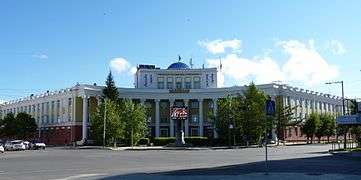National University of Mongolia
|
Монгол Улсын Их Сургууль ᠮᠣᠨᠭᠭᠣᠯ ᠣᠯᠣᠰ ᠣᠨ ᠶᠡᠬᠡ ᠰᠣᠷᠭᠠᠭᠣᠯᠢ | |
 | |
| Motto |
Эрдмийн хэт цахиваас, хөгжлийн гал бадармой The flame of progress flourishes from the forge of education |
|---|---|
| Type | public university |
| Established | 1942 |
| President | Ya. Tömörbaatar[1] |
Academic staff | 797 [2] (part-time 290, other 723) |
| Undergraduates | 15,889[2] |
| Postgraduates | 2,961[2] |
| 791[2] | |
Other students | 406 international students, 18 language preparatory students [2] |
| Location |
Ulaanbaatar, Mongolia 47°55′23″N 106°55′17″E / 47.9231°N 106.9213°ECoordinates: 47°55′23″N 106°55′17″E / 47.9231°N 106.9213°E |
| Campus |
Ulaanbaatar (main) Zavkhan (foreign languages) Orkhon (economics) Khovd (pedagogy) |
| Colors | Blue |
| Nickname | МУИС (MUIS) |
| Affiliations | CMUC, IAU, UMAP, CIEE, EAUN |
| Website | num.edu.mn |
 | |
The National University of Mongolia (Mongolian: Монгол Улсын Их Сургууль, Mongol Ulsyn Ikh Surguuli, abbreviated NUM or MUIS) is the oldest university in Mongolia, established in 1942 and originally named in honour of Marshal Khorloogiin Choibalsan. It hosts twelve schools and faculties in Ulaanbaatar, and runs branches in the Zavkhan and Orkhon Aimags. It has been estimated that approximately one third of the academically educated Mongolians are affiliated with NUM.
After Mongolia's first modern secondary school was established in 1921, it was necessary to bring in an academic institution at an even higher level. In 1942, the Government put forth Mongolia's first university, the National University of Mongolia, with the first students graduating in 1946. During socialism, the University served as a training center for the party elite. Education was paid for and strictly controlled by the state. After democratization, it gradually changed into a more modern university. In 1995, it started to offer bachelor's, master's, and PhD programs.
As of 2018, there were over 18,000 students enrolled[2] in various programs, mostly taught in Mongolian.
History
The National University of Mongolia was established on October 5, 1942, as the first modern university in Mongolia. The faculties were initially Pedagogy, Medicine, and Veterinarian Sciences. Agriculture, Natural Sciences, Mongolian Studies, Foreign Languages, as well as research activities were added shortly thereafter. Part of its operation were supported by staff and materials provided by the Soviet Union.

Some of these initial faculties spun off into separate universities, including the Agricultural University in 1958, the Medical University in 1961, as well as the Technical University and the University of Humanities in 1982.
In 1942, 93 students and 53 students enrolled to the preparation course in the University, and the first graduation was held in 1946, with 35 students.
In 1959, the rectorate of the university was changed to the Mongolian party. Namsrain Sodnom, a graduate of the university, was appointed as the first Mongolian president, while Ts. Sürenkhorloo was appointed as the vice-president for academic affairs.
In 1947, a postgraduate faculty was founded in order to prepare university lecturers and scientists.
In 1994, 13 students were awarded master's degrees. In 1997, the department of postgraduate affairs was established with the purpose to increase the number of postgraduate students.
Schools and faculties
Main faculties
- School of Business
- School of International Relations and Public Administration
- School of Law
- School of Engineering and Applied Sciences
- School of Arts and Sciences
Main faculties
- Foreign Language School in Orkhon Province
- Economics College in Zavkhan Province
Memberships and cooperations
NUM is a member of the following organizations:
- Consortium of Mongolian Universities and Colleges (CMUC)
- International Association of Universities (IAU)
- University Mobility in Asia and the Pacific (UMAP)
- Council on International Educational Exchange (CIEE)
- Euro-Asian University Network (EAUN)
It has cooperation agreements with more than 242 academic and research centers all over the world.
Notable faculty
References
- ↑ "ЗАХИРЛЫН МЭНДЧИЛГЭЭ". Retrieved 2018-05-20. . ЗАХИРЛЫН МЭНДЧИЛГЭЭ.
- 1 2 3 4 5 6 "Бидний тухай". Retrieved 2018-05-20. . Бидний тухай.
External links
| Wikimedia Commons has media related to National University of Mongolia. |